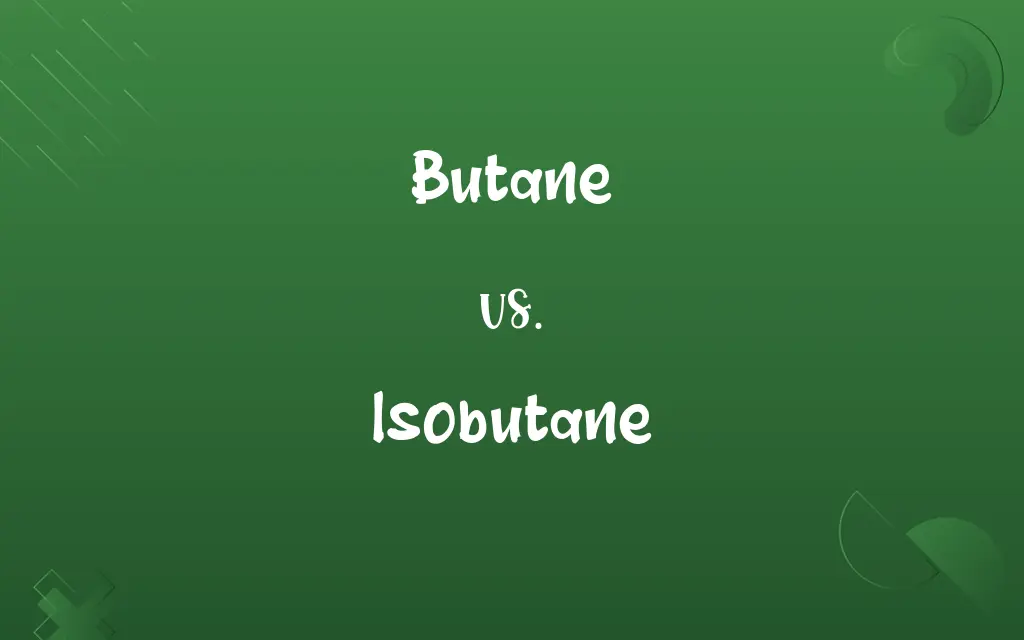Butane vs. Isobutane: Know the Difference

By Shumaila Saeed || Published on January 12, 2024
Butane is a straight-chain hydrocarbon (C4H10), used as fuel, while isobutane is a branched form of butane, used in refrigeration and aerosol propellants.

Key Differences
Butane, a hydrocarbon with the formula C4H10, consists of a straight chain of four carbon atoms. It is a colorless, flammable gas at room temperature and pressure. Isobutane, also a C4H10 hydrocarbon, differs in its structure; it has a branched chain, with a methyl group attached to the middle carbon atom. This structural difference imparts distinct physical and chemical properties to isobutane compared to butane.
Shumaila Saeed
Jan 12, 2024
In terms of chemical properties, butane and isobutane behave similarly as they are both alkanes. However, their different structures lead to variations in boiling points and vapor pressures. Butane has a slightly higher boiling point than isobutane. This difference makes isobutane more volatile and suitable for certain applications like refrigerants and aerosol propellants.
Shumaila Saeed
Jan 12, 2024
From a usage standpoint, butane is widely used as a fuel in lighters and portable stoves. It is also an important component of liquefied petroleum gas (LPG). Isobutane, due to its lower boiling point and higher volatility, is often used in refrigeration systems and as a propellant in aerosol sprays, exploiting its rapid vaporization.
Shumaila Saeed
Jan 12, 2024
The storage and handling of butane and isobutane require similar safety measures due to their flammability. However, isobutane's lower boiling point means it turns into gas more readily at lower temperatures, which can be an important consideration in its storage and transport.
Shumaila Saeed
Jan 12, 2024
In the realm of environmental impact, both butane and isobutane are relatively clean-burning fuels, producing fewer pollutants compared to other hydrocarbons. Isobutane is often preferred in applications like aerosols because it is less likely to contribute to ground-level ozone formation, making it a more environmentally friendly choice.
Shumaila Saeed
Jan 12, 2024
ADVERTISEMENT
Comparison Chart
ADVERTISEMENT
Butane and Isobutane Definitions
Butane
Butane has a relatively higher boiling point among light hydrocarbons.
Butane remains liquid under moderate pressure.
Shumaila Saeed
Dec 16, 2023
Isobutane
Isobutane is a branched isomer of butane, used in refrigeration.
The refrigerator uses isobutane as a coolant.
Shumaila Saeed
Dec 16, 2023
Butane
Butane is a gas at room temperature and atmospheric pressure.
The butane lighter quickly ignited the fire.
Shumaila Saeed
Dec 16, 2023
Isobutane
Isobutane is more volatile than straight-chain butane.
Isobutane's volatility makes it ideal for aerosol propellants.
Shumaila Saeed
Dec 16, 2023
Butane
Butane, C4H10, is used in LPG and lighter fuels.
Many portable heaters run on butane gas.
Shumaila Saeed
Dec 16, 2023
ADVERTISEMENT
Isobutane
Isobutane has a lower boiling point than butane.
Isobutane evaporates quickly at room temperature.
Shumaila Saeed
Dec 16, 2023
Butane
Butane is a colorless, flammable, straight-chain hydrocarbon.
Butane is commonly used as a fuel in camping stoves.
Shumaila Saeed
Dec 16, 2023
Isobutane
Isobutane, a C4H10 isomer, is used in cosmetic and industrial aerosols.
Many hair sprays contain isobutane as a propellant.
Shumaila Saeed
Dec 16, 2023
Butane
Butane is a clean-burning fuel producing minimal pollutants.
Butane is favored for its environmental efficiency in fuel.
Shumaila Saeed
Dec 16, 2023
Isobutane
(organic compound) A hydrocarbon, a particular isomer of C4H10 found in natural gas.
Shumaila Saeed
Dec 13, 2023
Butane
Either of two isomers of a gaseous hydrocarbon, C4H10, produced synthetically from petroleum and used as a household fuel, refrigerant, and aerosol propellant and in the manufacture of synthetic rubber.
Shumaila Saeed
Dec 13, 2023
Butane
(organic compound) A hydrocarbon (either of the two isomers of C4H10 n-butane, and 2-methyl-propane) found in gaseous petroleum fractions.
Shumaila Saeed
Dec 13, 2023
Butane
An inflammable gaseous saturated hydrocarbon, C4H10, of the marsh gas, or paraffin, series.
Shumaila Saeed
Dec 13, 2023
Repeatedly Asked Queries
In what state is butane commonly found?
Butane is commonly found in a gaseous state at room temperature and pressure.
Shumaila Saeed
Jan 12, 2024
What are some common uses of butane?
Butane is often used as a fuel in portable stoves, lighters, and torches, as well as in aerosol propellants.
Shumaila Saeed
Jan 12, 2024
What is the role of butane in the petrochemical industry?
Butane is used in the production of petrochemicals, including the manufacturing of synthetic rubber.
Shumaila Saeed
Jan 12, 2024
Is butane harmful to the environment?
Butane is considered a greenhouse gas, and its release into the atmosphere can contribute to environmental issues.
Shumaila Saeed
Jan 12, 2024
Where is isobutane commonly used?
Isobutane is used as a refrigerant, propellant in aerosol sprays, and as a fuel in camping stoves and lighters.
Shumaila Saeed
Jan 12, 2024
What is the chemical formula of butane?
The chemical formula of butane is C4H10.
Shumaila Saeed
Jan 12, 2024
Is butane highly flammable?
Yes, butane is highly flammable and should be handled with caution.
Shumaila Saeed
Jan 12, 2024
Is butane odorless?
Pure butane is odorless, but an odorant is often added for safety reasons to detect gas leaks.
Shumaila Saeed
Jan 12, 2024
What is butane?
Butane is a hydrocarbon gas with four carbon atoms and ten hydrogen atoms per molecule, belonging to the alkane family.
Shumaila Saeed
Jan 12, 2024
How does butane compare to propane as a fuel source?
Butane has a slightly lower energy density than propane but is preferred for indoor use due to its lower boiling point.
Shumaila Saeed
Jan 12, 2024
Can butane be liquefied under pressure?
Yes, butane can be liquefied under moderate pressure, making it suitable for storage in containers as a liquid.
Shumaila Saeed
Jan 12, 2024
Is isobutane flammable?
Yes, like normal butane, isobutane is highly flammable and should be handled with care.
Shumaila Saeed
Jan 12, 2024
Is isobutane considered a clean-burning fuel?
Isobutane is considered relatively clean-burning and is used in some environmentally conscious applications due to its lower environmental impact compared to other hydrocarbons.
Shumaila Saeed
Jan 12, 2024
What is isobutane?
Isobutane is a branched-chain hydrocarbon with four carbon atoms and ten hydrogen atoms per molecule, belonging to the alkane family.
Shumaila Saeed
Jan 12, 2024
How does isobutane differ from normal butane?
Isobutane has a different structural arrangement, with its carbon atoms branching off in a "T" shape, whereas normal butane has a linear structure.
Shumaila Saeed
Jan 12, 2024
What is the chemical formula of isobutane?
The chemical formula of isobutane is C4H10, the same as that of normal butane.
Shumaila Saeed
Jan 12, 2024
Is isobutane commonly used in the production of petrochemicals?
Isobutane is used in the production of isobutylene, a valuable petrochemical used in the manufacturing of various products.
Shumaila Saeed
Jan 12, 2024
Does isobutane have a distinctive odor?
Like butane, pure isobutane is odorless, but an odorant may be added for safety purposes.
Shumaila Saeed
Jan 12, 2024
What is the advantage of isobutane in refrigeration applications?
Isobutane is considered an environmentally friendly refrigerant due to its low global warming potential (GWP).
Shumaila Saeed
Jan 12, 2024
Can isobutane and butane be used interchangeably in all applications?
No, their different structural arrangements make them more suitable for specific applications; however, they can often be used interchangeably as fuels.
Shumaila Saeed
Jan 12, 2024
Share this page
Link for your blog / website
HTML
Link to share via messenger
About Author
Written by
Shumaila SaeedShumaila Saeed, an expert content creator with 6 years of experience, specializes in distilling complex topics into easily digestible comparisons, shining a light on the nuances that both inform and educate readers with clarity and accuracy.









































































